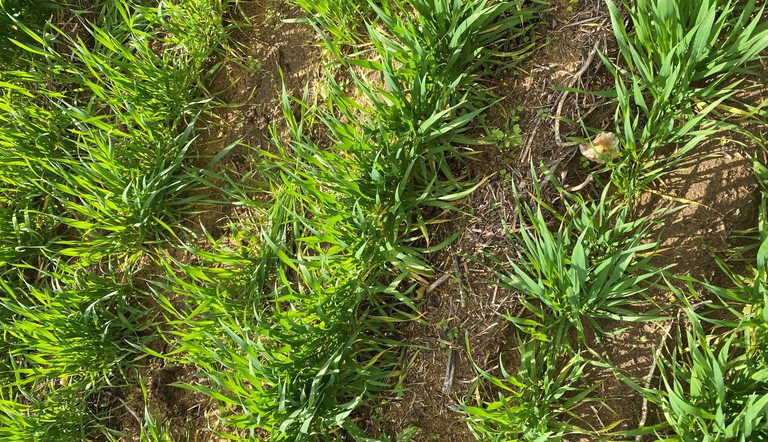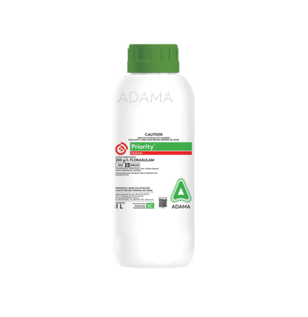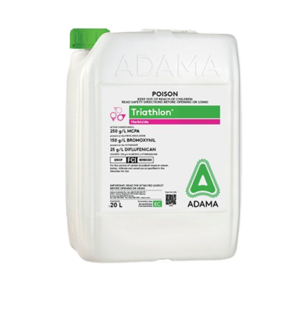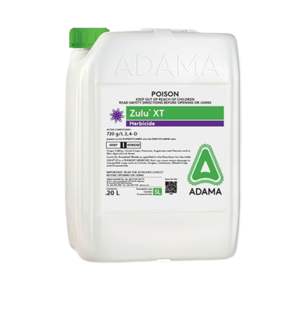
Powerful tank mix partner improving broadleaf weed control

One of the more powerful tank mix partners emerging in recent seasons, providing significantly improved broadleaf weed control from a range of herbicides in cereal crops, is the Group 2 post-emergent herbicide, Priority®, from ADAMA Australia.
Priority is a flexible and cost-effective tank mix partner that is helping to broaden the control of broadleaf weeds, as well as volunteer pulses and canola, and it is being praised by growers, particularly on hard-to-control weeds.
ADAMA Australia Portfolio Manager – Herbicides, Rob Walker, said Priority was an ideal choice in tank mixtures to improve the weed spectrum, targeting up to 54 broadleaf weeds depending on the tank-mix partner utilised, and to control volunteer, non-imidazoline tolerant varieties of canola and pulses. Importantly, it also offered excellent crop safety and allayed residue concerns in oaten hay and following crops and pastures.
Priority contains florasulam, an acetolactate synthase (ALS) inhibitor, in a suspension concentrate formulation and once absorbed via weed foliage, it is translocated to the growing points via the xylem and phloem.“An important benefit of florasulam is that it does not bind to stubble or plant material and has a relatively short half-life in the soil. Reduced soil residual enables greater flexibility for rotation crop options compared with other Group 2 herbicides such as metsulfuron or clopyralid (Group 4),’’ Rob said.
Priority is effective against susceptible weeds from the two to eight-leaf stage, depending on the weed species and/or weed size. It can be applied with registered tank mix partners including LVE MCPA 570, Triathlon®, Picoflex®, MCPA 750, Quadrant®, Zulu® XT, 2,4-D Amine, 2,4-D Ester, Flagship® 400 and Bronco® MA-X between the three and flag leaf crop stages (GS13-37).
Alistair Crawford, Market Development Manager with ADAMA Australia in Victoria, said in recent seasons, tank mixtures with Priority had proved the solution for broadleaf weed control in various cereal crops, especially with the wet conditions delaying applications. “Growers couldn’t get on their paddocks and weeds got bigger, but Priority then did really well with herbicides like 2,4-D, MCPA and Triathlon applied from mid-tillering through to growth stage 31,’’ Alistair said.
“It is really broad spectrum, so there is a mix that can control most broadleaf weeds. It is a cost-effective tank-mix or spike compared with alternatives, which, when you add other modes of action and oil, can be quite expensive.’’
He said Priority also could be applied early, from three-leaf to early tillering, with various herbicide modes of action. The excellent crop safety and favourable pre-harvest interval and plant-back profile with Priority makes it ideal for use in oats in Victoria, as well as cereal crops in the Mallee to control volunteer pulses and wild radish.
“Plantback issues can happen going into canola or a legume that often follow cereals, so this is important,’’ Alistair said.
In Western Australia, ADAMA Australia Market Development Manager Bevan Addison said Priority had been used across large areas in recent seasons and was extremely effective.
“It has been added to a lot of herbicide brews in the typical mid-season broadleaf application timing to pick up volunteer grain legumes including faba beans and vetch, and it is also used later as a radish mop-up,’’ Bevan said. “A lot of growers couldn’t get on to paddocks earlier, so they did later mop-ups and Priority has had huge success in this late period, taking out flowering radish. Some advisers said it worked ridiculously well.’’
He said Priority was in a sub-group of the Group 2 herbicides that had not been heavily exposed in the field and, hence, he urged responsible application of the herbicide to help safeguard its future use for growers.
“One of the main benefits of florasulam is its low residual, allowing minimal issues for any following crops that may be sensitive to longer residual Group 2 herbicides or clopyralid, for example. It will have a great fit where growers are wanting to remove clopyralid and SU’s (sulfonylureas) from their programs due to residual carryover into their grain legumes and legume pastures. Clopyralid and SU’s can really give them a headache.’’
Bevan said the wide range of tank mix partners Priority could be used with provided plenty of flexibility for growers, allowing them to adjust herbicide mixes according to crop type, weed spectrum and seasonal conditions.
Priority herbicide is registered for post-emergent application in cereals including wheat, barley, triticale and oats, established ryegrass pastures and fallow
Products in the Article

Priority®

Quadrant®

Triathlon®
